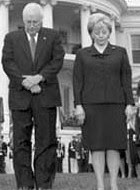The Oregon Country Fair (which runs for 3 days in the second week of July every year) has grown from its humble beginnings as an arts-and-crafts fair in 1969 to an event of international renown, attracting artists and musicians from all corners of the globe. It is billed as a "green" event, promoting environmentalism, recycling, alternate energy solutions, and various other Earth-friendly practices. The food, music, and crafts at the Fair are top-knotch. And the ambiance of the event is an experience that will deeply affect attendees: an other-wordly, hippie/stoner, rustic celebration of Earth and the inherent beauty of people.
In 1989 I was a young man of 27 years, only a year out of college and newly-entered into the working world of high technology. After one year in the high tech game, I was even then starting to realize that a professional career, which I had been striving to initiate for the previous 6 or 7 years, probably wasn't going to be the fulfilling endeavor that I had imagined.
So the day that my brother, Eric, my friend, Brian Davis, and I climbed onto that bus in Eugene and headed out to the "hippie festival" of which we had heard rumor, was to become a significant day of awakening in my life.
 |
| A tree-man at the 2007 Fair |
I had never before been exposed to the counterculture movement. For me, hippies were curios that I had rarely come into contact with, but by whom I was genuinely intrigued. Well, that first day, we three country boys from Klamath Falls were immersed into a bizarre world of tolerance, peacefulness, and love (yes, love) that forever changed our perceptions. All three of us were moved by the experience.
One brief story from that first visit in 1989 perhaps conveys the spirit of the Oregon Country Fair. It had been a long, dusty day wandering around in the "8" (which refers to the long, double loop of the main path within the Fair) gawking at all the sights and listening to the great music and browsing the wares of the vendors. I was hungry and couldn't decide between a bowl of jambalaya or a plate of fried rice. After some deliberation, I decided on the rice. I had just finished eating when I espied a beautiful young woman eating a bowl of the jambalaya. I shyly approached her, and asked her, "So, how is that jambalaya?" She smiled at me (a smile that would have charmed a man of stone), dipped her spoon into her bowl and loaded it with some delectable morsel. Then, without a word, she extended the spoon toward me. I opened my mouth and accepted the offer. "Thanks," I said. She smiled again and resumed eating. (And the jambalaya was delicious.)
This is but one of a myriad of experiences that routinely occur at the Fair. There was also the young man, dying of AIDS, at Global Village, with whom Eric and I spoke, who was determined to get the message out to prevent others from sharing his fate. There is Diane Patterson, the song-writer activist, whom I befriended, who spends her life touring, singing for peace and justice. There is Artis the Spoonman and Jim Page and the Kitchen Syncopaters.
Over the years, I have continued to attend the Oregon Country Fair. I have graduated from daytime visitor to official "Fair person," in that I am now associated with a crew that works at the Fair and am, therefore, an integral part of it, I suppose. I am the Fair; the Fair am I.
Some people complain that the Fair has become "too commercial" over the years, that the focus has strayed from its original intent. And I can't argue. But nothing is ever static in this world and, in my mind, it does little good to bemoan what is past (which is not to say that I don't indulge in thoughts of the "good ol' days" myself). But the Oregon Country Fair is still going strong, and I still come away from it every year with a feeling of rejuvenation and hope. And, these days, that's saying something.




































